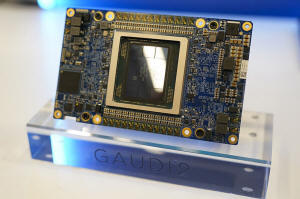Potential US semiconductor manufacturing boom complicated by Trump's
economic policies
[May 16, 2025] By
SARAH PARVINI
LOS ANGELES (AP) — Before “America First” became the Trump
administration’s mandate for foreign policy and trade, one sector was
already working to bring business back to the United States: the
semiconductor industry.
Aided by government incentives, American and foreign tech companies
alike have invested hundreds of billions of dollars to bolstering
semiconductor operations — research and development, manufacturing and
facility modernization — across the country in recent years.
In few places is the growth of the U.S. semiconductor industry clearer
than in the Greater Sacramento region, where tech leaders and lawmakers
have, for years, sought to grow California’s role in producing the chips
that power everyday necessities like cars, refrigerators and smartphones.
Semiconductor giants clustered in cities just outside Silicon Valley —
Intel, AMD, Bosch, Samsung and Micron — are building on a tech foothold
Intel first established when it opened its Sacramento-County campus in
1984.
But President Donald Trump’s economic policies have complicated that
growth as the administration takes its next steps toward imposing more
tariffs on key imports and launching investigations into imports of
computer chips and chip-making equipment — all at a time when deeper
semiconductor investments were just starting to have a positive impact
on changing supply chains. New tariffs, paired with the administration’s
threats against the CHIPS and Science Act, could dramatically slow its
goal of ensuring the U.S. maintains a competitive edge in artificial
intelligence development.

“You’re starting to see some of it now. Samsung announced a delay in the
fabs in Texas,” said Mario Morales, an analyst with the International
Data Corp. “That facility was supposed to come online in 2024 now it’s
being delayed to 2028. I think some of these companies are delaying it
because they now know that they’re not going to likely get funding, or
because of the uncertainty around the acts that we’re seeing around the
new trade policy.”
Although the U.S. is a major producer of certain types of semiconductor
chips, the nation's share of global chip production — measured by volume
and not dollar value — fell from 37% in 1990 to just 10% in 2022,
according to the Semiconductor Industry Association. As a result, the
country relies heavily on imports from Taiwan and South Korea for
advanced chips.
Major manufacturers like Taiwan Semiconductor Manufacturing Corp. are
investing to build up U.S. facilities, partly due to incentives put in
place during former President Joe Biden’s time in office. The CHIPS Act,
a law passed in 2022 with bipartisan support, was designed to revive
U.S. semiconductor manufacturing while sharpening the U.S. edge in
military technology and minimizing future supply chain disruptions.
Because of the CHIPS Act, the U.S. is projected to more than triple its
semiconductor manufacturing capacity — the highest rate of growth in the
world during that period, according to a May 2024 report from the
Semiconductor Industry Association and the Boston Consulting Group.
Barry Broome, president of the Greater Sacramento Economic Council, said
weaknesses in the semiconductor supply chain became evident during the
pandemic, when the U.S. experienced a shortage in supply. It was
“abundantly clear that having these chip products offshore in Vietnam,
Taiwan, China for cost savings had serious implications.”

Those pandemic-era challenges, paired with looming tensions between
China and Taiwan, have helped drive the industry to the Sacramento area,
he said. Northern California's wealth of tech knowledge and established
roots in the semiconductor industry are also attractive traits that have
brought investment to the Sacramento region as federal subsidies begin
to bolster domestic growth.
German tech company Bosch, for example, announced a $1.9 billion
investment in the Greater Sacramento area in 2023 to manufacture chips
for electric vehicles, converting its facility in Roseville into a
silicon carbide semiconductor production site.
[to top of second column] |

An Intel chip is displayed during an event called AI
Everywhere in New York, Thursday, Dec. 14, 2023. Intel is
introducing new products that are designed to be used with AI
powered computers and applications. (AP Photo/Seth Wenig, File)
 That investment, Bosch said, would
create as many as 1,700 jobs in construction, manufacturing,
engineering, and research and development. The project marks the
largest semiconductor investment in California in three decades,
according to Broome.
Tech workers who started out at companies like Intel have spun out
companies of their own, including Sacramento-area AI startup Blaize
and data storage manufacturer Solidigm.
Dinakar Munagala, cofounder of Blaize, said the company’s AI chips
are among the few built domestically. Their chips are made in a
Samsung foundry in Texas, he said. The company’s products, Munagala
added, help to power systems that analyze traffic patterns and
detect suspicious behavior in airports.
“We’re built here,” he said. “That’s one of the reasons we’re
actually getting quite a bit of interest from defense, border
security, these classes of use cases.”
Lane Bess, board chair of Blaize, pointed to Munagala — who worked
at Intel — as an example of the talent the Sacramento region can
provide to tech companies. The area is primed to be a main corridor
for the semiconductor industry because a lot of skilled workers are
looking to develop their own companies, Bess said.
The Trump administration has viewed chip production as a national
security issue because it would reduce U.S. reliance on importing
chips that are also used by the military. It also intends to study
the risks of having computer chip production concentrated in other
places and the impact on U.S. competitiveness from foreign
government subsidies, “foreign unfair trade practices and
state-sponsored overcapacity.”
Alvin Nguyen, senior analyst at Forrester, said the fluidity of the
state of administration's tariffs will cause confusion about the
impact on the supply chain “due to the complexity of tracking where
materials and manufactured goods are produced and assembled.”

Video game companies, for example, have started to raise prices amid
a backdrop of ongoing tariff uncertainty.
“For semiconductors, we may see certain goods no longer making sense
to produce due to the cost — see Nintendo Switch 2 — and the value
seen from IT purchases diminishing,” he said in an email.
Preorders for Nintendo’s highly anticipated Switch 2 were delayed in
April as retailers assessed the potential impact of tariffs.
Nintendo later confirmed that some Switch 2 accessories would see
price adjustments, but maintained that its baseline price for the
console — $449.99 — would remain the same.
Nguyen said that in the medium term, the growth of foundries around
the world will be beneficial to easing dependence on Taiwan for chip
production. Down the road, “we should see a healthier global
ecosystem for semiconductor manufacturing and more supply chain
options in where chips are produced and can be procured,” he said.
Broome, of the economic council, said he believes the Trump
administration's tariffs are aimed at restructuring global
relationships. He said he hopes that “concludes quickly” because
uncertainty over trade policy doesn’t favor the markets.
“If the tariffs are used for leverage to get better agreements in
the next two or three months, then we’ll come back quickly, and will
benefit from it,” Broome said. “If they’re considered long-term
policy, I think it’ll really ice the capital markets from putting
real money on the table.”
All contents © copyright 2025 Associated Press. All rights reserved |